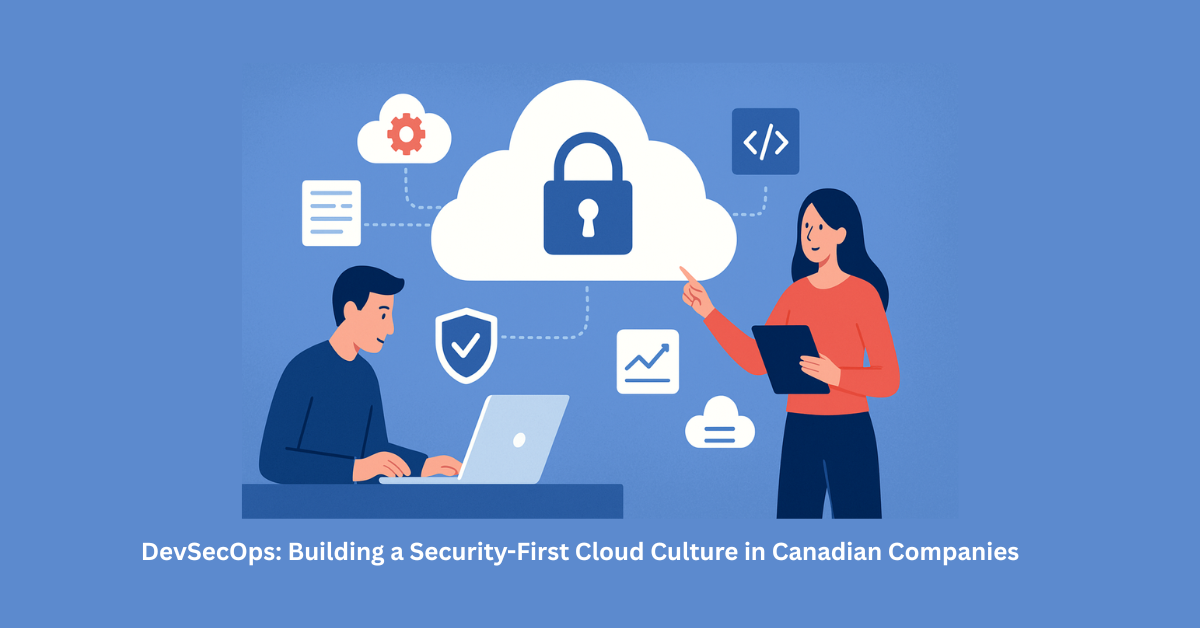Table of Contents
Cloud adoption in Canada is gaining momentum, with companies banking on digital platforms to remain competitive. But as companies move to the cloud, security threats multiply. That’s where DevSecOps fills the gap. By incorporating development, security, and operations, Canadian businesses can create a culture that prioritizes security right through the cloud lifecycle. This blog discovers why a security-first cloud culture is imperative, how DevSecOps operates, and actionable steps for Canadian companies to adopt it with success.
Introduction: Why Security-First is Important in Canada
In Canada, businesses are quickly adopting cloud computing to enhance scalability, flexibility, and cost-effectiveness. From fintech entrepreneurs in Toronto to healthcare organizations in Vancouver, cloud platforms are driving innovation. But with opportunity, there’s risk: cyberattacks, regulatory compliance, and data breaches are now matters of course.
Conventional security models, in which security is bolted on late in the development cycle, do not apply anymore. Security must now be infused into each phase of the software life cycle. That is the promise of DevSecOps—a practice that marries security with DevOps methodology to create more secure, more resilient systems.
Across Canada, where industries such as finance, healthcare, and government handle sensitive information, embracing a cloud-first security culture is not a choice—it’s a necessity.
What is DevSecOps?
Fundamentally, DevSecOps is about moving security left—injecting security checks, tools, and practices earlier in the development pipeline. Rather than security being a bottleneck at the end, it becomes an ongoing, automated process that happens in tandem with development and operations.
In simple terms, DevSecOps assures that each code commit, deployment, and cloud resource is tested with security in mind.
Key principles are:
- Automation: Security tests are automated, reducing the risk of human error.
- Collaboration: Security teams, operations, and developers collaborate.
- Continuous monitoring: Security does not end at deployment; it is ongoing in production.
- Education: Teams learn to think like an attacker and develop defensively.
Why Canadian Companies Need DevSecOps
1. Growing Cyber Threats
Canadian companies are experiencing an increasing tide of insider, phishing, and ransomware attacks. Financial institutions and healthcare are particularly targeted, as indicated by the Canadian Centre for Cyber Security. DevSecOps minimizes threats through proactive, uninterrupted security.
2. Regulatory Compliance
Canada has robust data privacy legislation, including the Personal Information Protection and Electronic Documents Act (PIPEDA), and industry-specific guidelines like PCI DSS for banking and HIPAA for health care. Embedding compliance in pipelines is how DevSecOps ensures organizations fulfill these requirements without hindering innovation.
3. Cloud Complexity
The majority of Canadian businesses are running in hybrid or multi-cloud environments (AWS, Azure, GCP). This creates complexity and makes manual security impossible. DevSecOps applies automation to implement consistent policies across platforms.
4. Customer Trust
Security compromise harms reputation and destroys customer trust. For Canadian businesses in highly competitive markets, visibility into a security-first cloud culture is a key differentiator.
Building a Security-First Cloud Culture
Converting to DevSecOps is not a matter of tools, but of people, processes, and mindset. This is how Canadian businesses can establish this culture:
1. Begin with Leadership Buy-In
Leaders should become proponents of security as a business value, rather than an IT concern. When executives support DevSecOps, teams come together more readily.
2. Continuously Educate Teams
Security awareness training is vital. Developers should learn secure coding practices, operations teams should understand cloud vulnerabilities, and security teams should be embedded in projects from the start.
3. Automate Security in Pipelines
Integrate tools for static application security testing (SAST), dynamic testing (DAST), and dependency scanning directly into CI/CD pipelines. For example, every new build can be automatically checked for vulnerabilities.
4. Implement Cloud-Native Security Tools
Canadian companies that utilize AWS, Azure, or GCP must utilize their integrated security features: identity and access management (IAM), encryption capabilities, and threat detection tools. Combining these with third-party solutions adds further protection.
5. Monitor Continuously
Security does not end when deploying. Utilize continuous monitoring for suspicious activity, failed login attempts, or unauthorized activity. Adding AI-powered tools can increase the detection and response times.
6. Encourage Shared Responsibility
In a security-first cloud culture, security is everyone’s responsibility. It’s not solely the security team’s responsibility—it’s everyday work for developers, testers, and operations personnel.
Shared Challenges (and How to Get Past Them)
Even with good intentions, Canadian businesses might encounter obstacles:
Resistance to change: Traditional workflows’ accustomed teams might push back against new processes. Solution: begin small with pilot initiatives to show value.
Dean Wattson.
Tool overload: Having too many tools overwhelms teams. Solution: pick integrated platforms that scale.
Skills gap: Not all teams have security training. Solution: spend on upskilling and cloud security-specific certifications.
Budget concerns: Security can be expensive to buy upfront. Solution: frame DevSecOps as an investment that saves much more costly breaches.
Case in Point: DevSecOps in Canadian Industries
- Finance: Toronto banks are implementing DevSecOps to meet stringent regulations while deploying digital banking apps securely.
- Healthcare: Ontario hospitals implement cloud-native security tools to secure patient data under HIPAA while embracing telemedicine platforms.
- Startups: Vancouver tech startups employ DevSecOps pipelines to go fast without sacrificing trust, hence more appealing to investors.
These examples show that whether you’re a large enterprise or a small startup, a security-first cloud culture powered by DevSecOps pays off.
Future of DevSecOps in Canada
As AI, IoT, and 5G expand in Canada, the attack surface will only grow. The future of DevSecOps lies in deeper automation, AI-driven threat detection, and tighter integration with compliance frameworks. Companies that adopt this early will lead in both innovation and trust.
Conclusion
For Canadian companies, cloud adoption is no longer optional—but neither is security. DevSecOps offers a practical way to embed security into every stage of development and operations, creating a security-first cloud culture that builds resilience, meets regulations, and earns customer trust.
The trip is not without obstacles, but the reward is evident: fewer compromises, quicker innovation, and better customer trust. With DevSecOps, Canadian companies can be successful in the digital economy while being secure in the cloud-first world.

